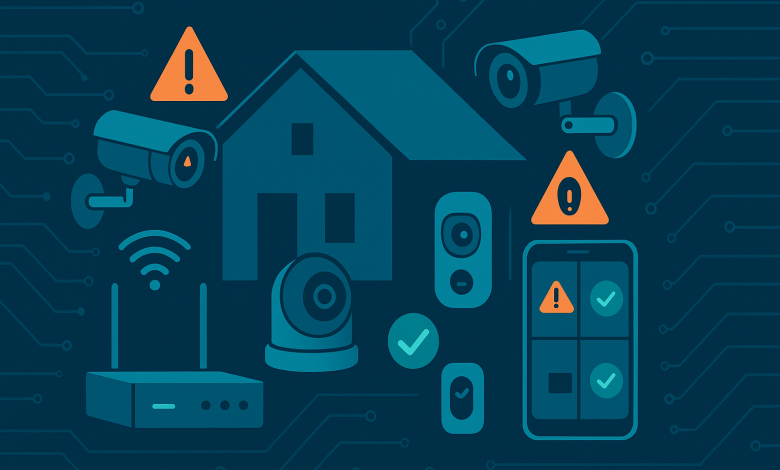
Theft deterrence security with camera systems is now fair game in our world regardless if you are just securing a studio apartment, a big family home or a retail store. Even the most well-behaved security cameras can act up at the worst of times. The live video freezes, the image becomes fuzzy or the app will not load when trying to view on mobile networks outside your home.
The good news is that almost all problems are not so hard to fix once you know what is really going on under the hood. You will not see it here, as this is my actual radio programming cheat-sheet full of real-world troubleshooting that works for me and I recommend to you – written in plain language. You will be taught how to stabilise your security cameras, achieve better quality videos and also help prevent the problems in future.
Understanding Security With Camera Systems
You cannot fix anything you cannot identify. There are many problems that come from power, network, storage, or software instead of the camera hardware.
How Modern Security Cameras Work
The majority of systems today will be set up one of two ways.
There are IP based security cameras that connect over your network. They transmit video over Wi Fi or Ethernet to a recorder, a cloud service, or your phone app. These are popular among smart home kits and businesses.
CCTV cameras come in both analog and digital models, the latter of which use coaxial cables to link to a DVR. They do not draw from your home network in the same way but still require consistent power, reliable cabling and sufficient storage.
In either situation in your security with camera setup, it is the collusion of camera type, its recorder or cloud only service, the network, power supply and the view device. If any single part fails, everything appears to be failing.
Types of Security Cameras You May Have Installed
You could have a hodgepodge of cameras on the same property.
You might be using:
- Living room or hallway cameras
- Indoor Wi Fi cameras
- Water resistant outdoor door and driveway cameras
- Model classification based on the panning and tilting: Wide field-of-view pan and tilt cameras
- Battery operated cameras (rechargeable or solar)
Each category has its own weaknesses. For one, battery models often fail because they run low on charge, whereas wired models typically fail due to loose cables or overloaded power adapters. Remember this as you look through the fixes below.
Typical Security Camera Issues and Solutions
We will now investigate the common gripes and easy solutions that you can implement right away. It is ok, you do not have to know anything about computers or (especially) printers to do this.
Camera Is Not Showing Video or Displays a Black Screen
It is also one of the most distressing things, as it can feel like complete and utter failure. Usually, the reason is simple.
First of all, check if the camera is actually working. Verify the power adapter, extension cord, or PoE switch. On the camera body, find a low-tech status light. If there is no light, then test a different power outlet or USB cable.
Second, check if the camera is properly attached to the recorder/router/app. Reseat the Ethernet or coaxial connection on wired cameras. Make sure the device is still showing up in your app for Wi Fi cameras and that it has the same network as your phone.
Third, if you have an NVR or DVR unit, reboot it. I have resurrected plenty of “dead” security cameras just by restarting the recorder and letting it detect the channel again.
If the camera is online but your app still shows a blank screen, log out of the application and close it. Then log in again. If that does not work, update the app or look at the camera from another device, such as a laptop versus a smartphone, for example.
The Picture Is Out of Focus, Too Grainy or Distorted
Bad picture quality renders any security of the camera configurations almost pointless, but fortunately it is typically uncomplicated to fix.
Start with the lens. Dust, fingerprints and even spider webs can cause footage to look soft or foggy. Wipe the glass with a soft microfiber cloth and a bit of lens cleaner or some water. Do not use sand paper or chemicals.
Now, have a look at focus and resolution. On some cameras we can manipulate a physical focus ring. Some of them have to be set up through the app or through the recorder functions. Ensure the resolution is set to full HD or even higher instead of a lower default to help save on bandwidth.
Lighting is another big factor. If your subject is backlit by a bright window or a car headlight, faces will appear dark and noisy. Consider moving the camera so the light hits your subject instead of shining right toward the lens. If your camera has a wide dynamic range (WDR) or HDR mode, turn it on. This can be a huge boost for security cameras in challenging lighting situations.
If the live view image is blocky or pixelated, but the recorded footage looks clear, it could be your network speed. When recording, many systems will allow you to set one quality of stream for recording and a lower-quality version for remote access. Consult your bit rate and stream settings in the camera menu.
Night Vision Not Working Properly
Issues with night vision are typically straightforward to diagnose. Footage is too dark, or faces are blown out and white.
The first thing you should do is ensure that night mode is either set to automatic or switched on manually. In well-lit spaces, some cameras never toggle on their infrared mode, the switch that says night vision. Turn the lights off and check if the camera switches to IR mode.
Then check for obstructions in the camera. In some cases of outdoor models of security cameras, coverings for the lens or infrared ring are made of plastic and then wrap present over it. These films bounce IR light back into the lens and create a milky halo. Remove them carefully.
Please do not point the camera at white walls or glossy or reflective objects. Infrared light can also bounce back and confound the sensor. Pull doors or gates to reangle and slightly adjust the angle so IR light goes on subjects and not a close wall or gutter.
If your night vision is not as good as you expect, make sure the lens is clean and not wet or foggy, and verify that the IR LEDs are actually on at night. You can usually see a dim red glow if you look carefully. If it does not glow, the IR systems might have gone bad and will need a replacement.
Wi Fi Camera Keeps Disconnecting
It is unstable Wi Fi that causes a lot of the issues we have with security with camera systems.
Simply put the camera at a realistic distance from your router. Signal strength can be diminished significantly by walls, metal doors and thick concrete. If you are working with a bar of signal, get ready for plenty of dropouts. See if you can move the camera a little closer, or turn the antenna (if it has one).
Reboot your router and camera. When debugging for friends and clients, usually a restart on both ends will fix most random disconnects.
Pair your camera with the less crowded band if you can. On 2.4 GHz and 5 GHz, some dual band routers also offer both. Most security cameras like 2.4 GHz because it travels farther despite being slower.
If you have more than a couple of cameras or other smart devices, consider adding a mesh Wi Fi system or dedicated access point to stabilise your security cameras without competing with heavy streaming traffic.
Motion Detection Is Either Over-Sensitive or Too Little
You know, motion alerts that never stop coming are just as horrible as no alerts at all. In most cases, the fix is in system settings.
Open your camera or recorder app and locate the motion detection section. On many systems, you can set detection zones. Draw and exclude a zone around such vantages as doors, gates and driveways, but do not include things like trees and streets. This one change could slash the number of false alarms.
Adjust the sensitivity level. If you find that you receive alerts every time light conditions change or shadows move, reduce the sensitivity. If you keep missing pedestrians crossing the frame, try giving it a small lift. Walk through the monitored area and test changes as you go.
Human detection or person only alerts are also available on some modern security cameras. Staying aware of these can help minimise pets and passing cars from cluttering up the visual quality of your camera system without unnecessary noise.
Security Cameras Not On or Recording Over Itself
If your system is not recording at all, or if video seems to disappear sooner than you anticipated, storage is almost always the issue.
First, verify that recording has been enabled from the schedule menu. A lot of users change recording to event only by mistake, or even disable the schedule altogether when playing around with settings. Ensure the schedule is set to “always” or to times of day you actually want.
Second, check the storage device. For NVR and DVR systems, check that the hard drive is detected in the system information menu and that it is healthy. For Wi Fi cameras that record to microSD cards, verify the card capacity, and if it was used on another device, format it in the camera settings.
It is worth noting that HD video is going to take up a lot of space. If desired, for more days of storage, lower the bit rate slightly or change frame rate from 30 fps to 15 fps. It still looks grainy for security purposes now with that giant camera footage, but you get more days of history.
Remote Viewing App Not Working
You try to access the app while you are not at home, and nothing comes up. That can be frustrating when you just want to briefly glance at your security cameras from the road.
The first time, test the app on your home Wi-Fi. If you see local cameras but mobile data is blocked or will not pass the stream, it is not really the camera that may have a problem, but rather your router, port forwarding and cloud service.
Your recorder or camera must be able to access the internet. Make sure the date and time are accurate, and then make sure that the device is connected to your router by live Ethernet cable or is within range of your Wi Fi network.
Bitte installiere für ein besseres Erlebnis einen moderneren Browser. Remove and re connect it or something like that. If your brand provides a cloud account or P2P, log in on the recorder and the app. This can ease the burden of remote access versus manual port forwarding.
Lavax Maintenance for a Safely Operating Camera Surveillance System
After you solve the problem sitting inside your sock or stuck in a shoe, it is wise to stop it from coming back. Just a few basic habits, and your security with camera setup can work for years.
Simple Monthly Checks
Go around your property once a month and examine each camera. Make sure the angle is still going to capture what you had in mind and no obstacles are in between. If you see dust, water spots or cobwebs, clean the lenses gently.
Open your app or recorder and do a fast check-through on every single channel. Check to see if a recording is in progress, and that there is available disk space on your hard disk. Also check the time and date are correct. This will only take a few minutes and it will prevent you from ever missing content when you want it most.
When to Call a Professional
Many software and hardware problems can be solved without a professional’s help, especially those related to basic errors or security threats, but there is much that cannot.
Think about bringing out an installer if there are damaged cables in your walls, if you are experiencing more than one camera losing power on good weather days, or ones that need verification of the recording requirements for HD among other things. A professional can even modify your layout so there are no blind spots and every entry point in them will be covered.
FAQs
Why does my security camera go offline?
The majority of offline issues come down to bad Wi Fi, intermittent power, or old firmware. First, make sure signal strength and power connections are good, then try cold-booting both the camera and the router. Lastly, check the app or settings menu for firmware updates and install them carefully.
How frequently should I replace my security cameras?
None of this is set in stone, but the image sensors or infrared systems may gradually wear out after a few years of near-continuous use. If you get footage that looks significantly worse than even more recent models, or if your camera is no longer getting security updates, it may be time to upgrade for reliability and smarter features.
Do security cameras work without the internet?
Yes, a lot of security cameras can record to a DVR or NVR or to your local SD card without being connected to the internet. The only thing you do need is the internet for remote viewing and cloud storage. Local only recording, to keep all video private Swing mit Ihrem eigenen Local only recorden.
Why are my night images so bright and white?
Night vision that is overexposed is typically caused by putting the camera too close to walls, reflective surfaces or items such as white doors. Invisible light bounces right back into the lens. Tilt the camera to point slightly off surfaces nearby, back it up an inch or two, or better, reduce the IR strength in settings when available.
How many security cameras do I need for my home?
That ideal number varies depending on your configuration, though you can start by covering every major entry point into a data center and any soft targets like loading docks or side gates. For a standard small home, three to six strategically placed security cameras are typically more than sufficient as long as each camera has clear sight lines and consistent lighting.



